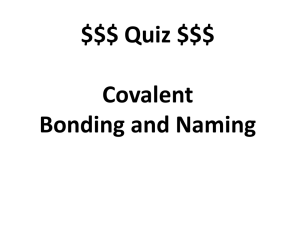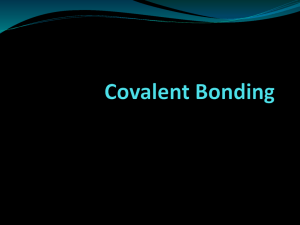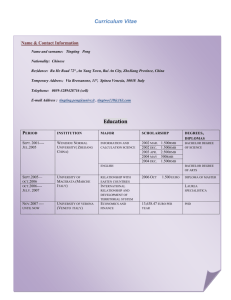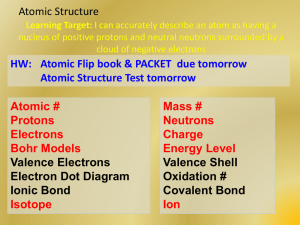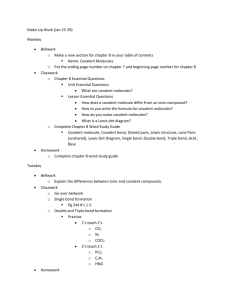GC Bonding.notebook
advertisement
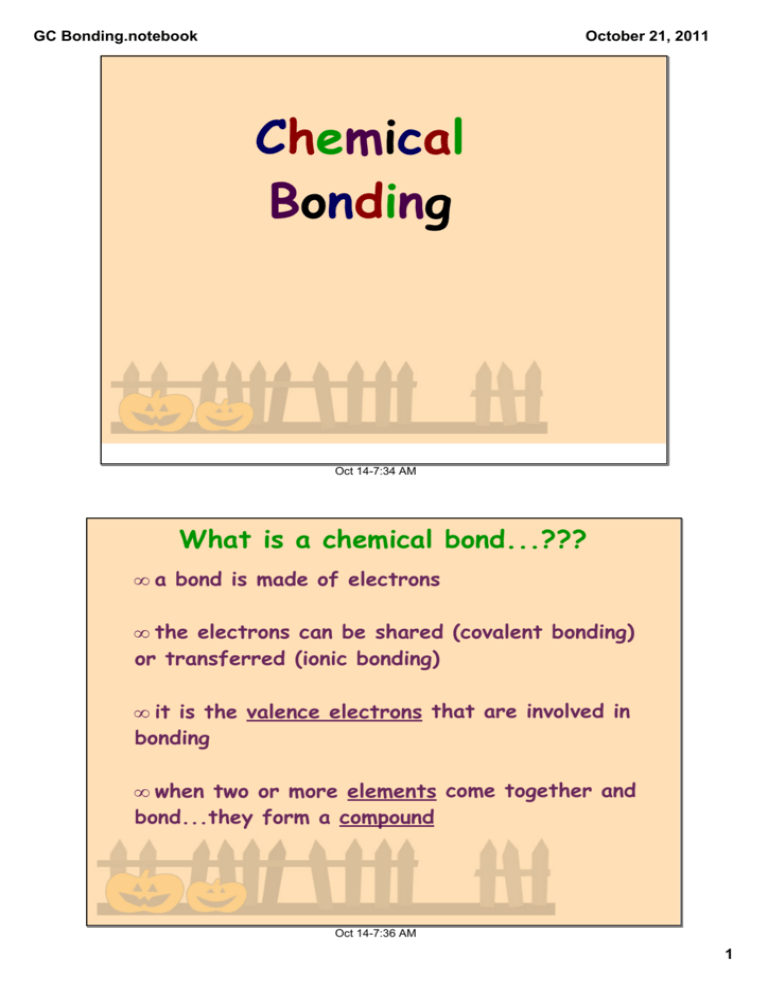
GC Bonding.notebook October 21, 2011 Chemical Bonding Oct 14­7:34 AM What is a chemical bond...??? • a bond is made of electrons • the electrons can be shared (covalent bonding) or transferred (ionic bonding) • it is the valence electrons that are involved in bonding • when two or more elements come together and bond...they form a compound Oct 14­7:36 AM 1 GC Bonding.notebook October 21, 2011 Covalent Bonding & Compounds: • two or more nonmetals bonded together • electrons are shared between the two atoms in the bond • Properties of covalent compounds: low melting and boiling points usually do not dissolve in water do not conduct electricity when dissolved in water Oct 14­7:39 AM Naming Covalent Compounds... • name the 1st element with its periodic table name • change the ending of the 2nd element name to "-ide" • indicate the # of each atom with a prefix (mono = 1, di = 2, tri = 3, etc...) • the prefix "mono" (1) is optional for the 1st element and required for the 2nd • if there are two vowels together between the prefix and the element name - you can drop the element name vowel Example: triiodide = triodide, monooxide = monoxide Oct 14­8:56 AM 2 GC Bonding.notebook October 21, 2011 Naming Covalent Compounds: SF6 C3H8 N2O6 NO Oct 14­7:44 AM Writing Covalent Compound Formulas iodine tribromide nitrogen trioxide diphosphorus tetraoxide carbon tetrafluoride Oct 14­8:51 AM 3 GC Bonding.notebook October 21, 2011 On pg # 1 in your packet at the bottom...try... #3 SF6 #4 C3H8 #6 N2O6 sulfur hexafluoride tricarbon octahydride dinitrogen hexaoxide #11 iodine tribromide #12 nitrogen trioxide #13 diphosphorus tetraoxide IBr3 NO3 P2O4 Oct 14­9:01 AM What are Lewis Structures? • Show the bonding in a covalent compound in picture form. • Bonds are represented by lines, non-bonded electrons by dots. • a bond (1 line) = 2 electrons • From the Lewis Structure you can determine the shape of the compound, which helps determine the properties of that compound. Oct 14­7:52 AM 4 GC Bonding.notebook October 21, 2011 Lewis Dot Structures of Atoms H Be B C N linear trigonal tetra- trigonal planar hedral pyramid O F Ne # valence e# bonds shapes linear ** bent linear Be is a metal, but still can covalently bond because of its small atomic radius. It is small enough to have its valence electrons overlap with another atom's valence electrons. Oct 14­7:52 AM Drawing Lewis Structures...The Rules 1. Add up the total # of valence electrons in the formula. 2. Determine the central atom. the first atom listed (except for hydrogen) or... the atom with the least number of valence electrons (except for hydrogen) 3. Bond all the other atoms to the central atom. Use lines to represent the bonds. (Remember: each bond = 2 electrons) Oct 14­7:58 AM 5 GC Bonding.notebook October 21, 2011 The Rules Continued... 4. OCTET RULE: Every atom in the structure must have 8 electrons around it. Fill in the octets using PAIRS of electrons (dots). Exceptions: Hydrogen (H) - 2 electrons or 1 bond Beryllium (Be) - 4 electrons or 2 bonds Boron (B) - 6 electrons or 3 bonds 5. Check: total # electrons in picture = # valence electrons counted Oct 14­8:02 AM The Rules Continued... 6. CARBON - MUST HAVE 4 bonds, no dots!!! 7. DO NOT string oxygens together O 8. DO NOT make boxes C C C C O O... Oct 15­7:37 AM 6 GC Bonding.notebook October 21, 2011 Single Bond Examples: 1. Cl2 valence e-: shape: 2. SiF4 valence e-: shape: Oct 15­7:32 AM 3. H2O 4. OH-1 valence e-: shape: valence e-: shape: Oct 15­7:34 AM 7 GC Bonding.notebook 5. NH3 valence e-: shape: October 21, 2011 6. N2H4 valence e-: Oct 15­7:35 AM 7. C3H8 valence e-: 8. C2H5OH valence e-: Oct 15­7:36 AM 8 GC Bonding.notebook October 21, 2011 Double & Triple Bonds 1. O2 2. N2 Oct 18­8:53 AM 3. C2I4 4. C2H5O Oct 18­8:53 AM 9 GC Bonding.notebook October 21, 2011 Lewis Structures for Ions Positive Ions: subtract the # of electrons in the charge from the total Negative Ions: add the # of electrons in the charge to the total PO4-3 Oct 15­7:45 AM 10
